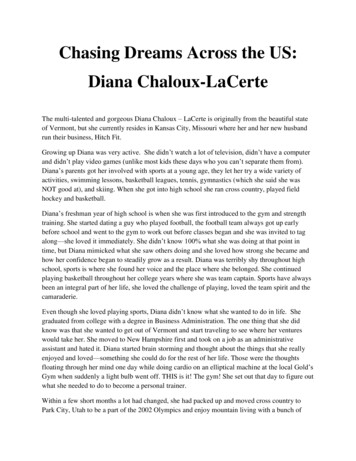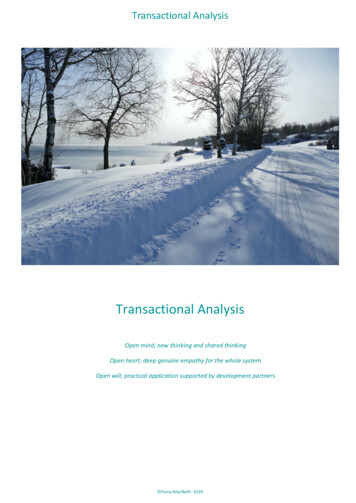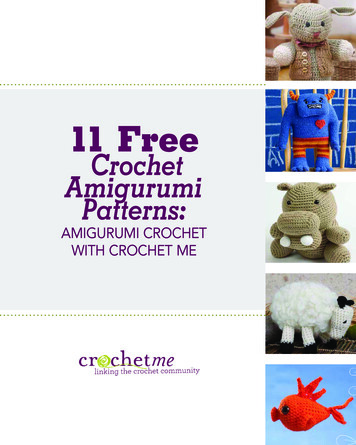
Transcription
HOOKEDTHE BRAIN SCIENCEON HOW CASUAL SEXAFFECTS HUMAN DEVELOPMENTJOE S. MCILHANEY JR., MDFREDA MCKISSIC BUSH, MD
e brain and its lobes within the cerebral cortex.
The neural circuit. This includes the neuron’s cell body, the axon extending from one neuron to another, and the synapse, or connection pointbetween two neurons in the brain. The synapse is the functional connection point between two neurons.
eaAreas of the brain that are involved with the production and transmission of dopamine. Dopamine is involved in “rewarding” the brain forrisky or exhilarating behavior. This might include positive things such asgood grades or negative things such as driving too fast.
InsulaAmygdalaAreas within a woman’s brain believed to be involved in the developmentof trust and trustworthiness. The brain chemical oxytocin likely plays animportant role in these processes and is involved in maternal care, socialattachment, and bonding. Perception of another person’s face is associated with an emotional response within the amygdala. The insula helpstranslate this emotional response into a feeling about the person.
Five Years OldTwelve Years OldTwenty Years OldThe prefrontal cortex of the brain is not mature until a person grows outof adolescence and into their midtwenties. Shaded portions representthe growing complexity and sophistication of the brain from age five toage twenty. This development is a key factor in an individual’s ability tomake mature judgment decisions.
exSide view of brain areas most commonly involved in mature love. Brainareas most commonly involved in mature or long-lasting and committedlove.
eaThe locations of the brain believed to be most involved with depression.
NotesChapter 1: Let’s Talk Sex1. National Institutes of Health, “Puberty and Precocious Puberty: Condition Information,” nditioninfo/default.2. “Sexually Transmitted Diseases (STDs),” Centers for Disease Control andPrevention, www.cdc.gov/std/.3. Ibid.4. K. Paige Harden, “Genetic influences on adolescent sexual behavior: Why genesmatter for environmentally oriented researchers,” Psychological Bulletin 140, no. 2(2014): 434.5. Jan Pringle et al., “The physiology of adolescent sexual behaviour: A systematicreview,” Cogent Social Sciences 3.1 (2017): 1368858.6. L. Kann, T. McManus, W. A. Harris et al., “Youth Risk Behavior Surveillance—United States, 2017,” MMWR Surveillance Summaries 67, no. 8.7. M. O. Ogunsola, “Abstinence from Premarital Sex: A Precursor to QualityRelationship and Marital Stability in Subsequent Marriage in Nigerian Society,”International Journal of Psychological Studies 4, no. 2: June 2012.8. Kann, McManus, Harris et al., “Youth Risk Behavior Surveillance—UnitedStates, 2017.”9. W. B. Wilcox and N. H. Wolfinger, “Men and Marriage: Debunking the Balland Chain Myth”, Institute for Family Studies, archbrief-menmarriage-083117.pdf, accessed June 2018.10. American College of Pediatricians, “The Teenage Brain: Under Construction,”May 2016 r-construction.11. Frances E. Jensen, The Teenage Brain (New York: Harper Collins, 2015).Chapter 2: Meet the Brain1. J. Mendle, J. Ferrero, S. R. Moore, and K.P. Harden, “Depression and AdolescentSexual Activity in Romantic and Nonromantic Relational Contexts: A GeneticallyInformative Sibling Comparison,” Journal of Abnormal Psychology 122, no. 1(2013): 51–63. H. Savioja, M. Helminen, S. Frojd et al., “Sexual experience andself-reported depression across the adolescent years,” Health Psychology andBehavioral Medicine 3, no. 1 (2015).2. Mark Regnerus and Jeremy Uecker, Premarital Sex in America: How YoungAmericans Meet, Mate, and Think about Marrying (Oxford: Oxford UniversityPress, 2011), 66.
3. J. A. Hess and T. A. Coffelt, “Verbal Communication about Sex in Marriage:Patterns of Language Use and Its Connection with Relational Outcomes,” Journalof Sex Research 49.6 (2012): 603–12.4. Regnerus and Uecker, Premarital Sex in America, 81.5. Frances E. Jensen, The Teenage Brain (New York: Harper Collins Publishers,2015).6. G. J. O. Fletcher, J. A. Simpson, L. Campbell, and N. C. Overall, “Pair-Bonding,Romantic Love, and Evolution: The Curious Case of Homo sapiens,” Perspectiveson Psychological Science 10, no. 1 (2015): 20–36.7. Bryan Kolb and Robbin Gibb, “Brain Plasticity and Behaviour in the DevelopingBrain,” Can Acad Child Adolesc Psychiatry 20, no. 4 (Nov. 2011): 265–76. MarkusButz and Arjen Van Ooyen, “A Simple Rule for Dendritic Spine and AxonalBouton Formation Can Account for Cortical Reorganization after Focal RetinalLesions,” PLOS One Computational Biology 9, no. 10 (October 2013).8. Jensen, The Teenage Brain, 48.9. Kolb and Gibb, “Brain Plasticity and Behaviour in the Developing Brain,”265–76.10. Ibid.11. Ibid.12. Jensen, The Teenage Brain, 70.13. Ibid., 54.14. S. J. Blakemore and T. W. Robbins, “Decision-making in the adolescent brain,”Nature Neuroscience 15, no. 9 (Sept. 2012).15. Jensen, The Teenage Brain,103–104.16. Ibid., 114.17. Ibid., 108.18. Ibid.19. Ibid., 109.20. Ibid., 111.21. Fletcher, Simpson, Campbell, and Overall, “Pair-Bonding, Romantic Love, andEvolution,” 20–36.22. Tiffany M. Love, “Oxytocin, Motivation and the Role of Dopamine,” Pharmacology Biochemistry and Behavior 119 (April 2014): 49–60.23. Ibid.24. M. A. Whisman and D. K. Snyder, “Sexual Infidelity in a National Survey ofAmerican Women: Differences in Prevalence and Correlates as a Function ofMethod of Assessment,” Journal of Family Psychology 21, no. 2 (2007): 147–54.25. W. B. Wilcox, J. R. Anderson, W. Doherty et al., “Why Marriage Matters, ThirdEdition: Thirty Conclusions from the Social Sciences” (New York: Institute forAmerican Values National Marriage Project, 2011).26. R. Hurlemann and D. Scheele, “Dissecting the Role of Oxytocin in theFormation and Loss of Social Relationships,” Biological Psychiatry 79 (Feb.2016):185–93.27. Fletcher, Simpson, Campbell, and Overall, “Pair-Bonding, Romantic Love, andEvolution,” 20–36. Hurlemann and Scheele, “Dissecting the Role of Oxytocinin the Formation and Loss of Social Relationships,”185–93. K. A. Young, K. L.Gobrogge, Y. Liu, and Z. Wang, “The Neurobiology of Pair Bonding: Insightsfrom a Socially Monogamous Rodent,” Front Neuroendocrinology 32, no. 1 ( Jan.
Notes2011): 53–69. Z. V. Johnson and L. J. Young, “Neurobiological mechanisms ofsocial attachment and pair bonding,” Current Opinion in Behavioral Sciences 3( June 2015): 38–44.28. I. Schneiderman, O. Zagoory-Sharon, J. F. Leckman, and R. Feldman, “Oxytocin during the initial stages of romantic attachment: Relations to couples’ interactive reciprocity,” Psychoneuroendocrinology 37, no. 8 (Aug. 2012): 1277–85.A. Meyer-Lindenberg, G. Domes, P. Kirsch, and M. Heinrichs, “Oxytocin andvasopressin in the human brain: social neuropeptides for translational medicine,”Nature Reviews Neuroscience 12 (Sept. 2011): 524–38.29. Fletcher, Simpson, Campbell, and Overall, “Pair-Bonding, Romantic Love, andEvolution,” 20–36. L. Brizendine, The Female Brain (New York: Broadway, 2006),68.30. Hurlemann and Scheele, “Dissecting the Role of Oxytocin in the Formationand Loss of Social Relationships,” 185–93. P. Sun, A. S. Smith, K. Lei et al.,“Breaking bonds in male prairie vole: Long-term effects on emotional and socialbehavior, physiology, and neurochemistry,” Behavioural Brain Research. 15:265(May 2014): 22–31.31. Young, Gobrogge, Liu, and Wang, “The Neurobiology of Pair Bonding,” 53–69.32. C. F. Zink and A. Meyer-Lindenberg, “Human Neuroimaging of Oxytocinand Vasopressin in Social Cognition,” Hormones and Behavior 61, no. 3 (March2012): 400–409.33. Young, Gobrogge, Liu, and Wang , “The Neurobiology of Pair Bonding,” 53–69.34. Jensen, The Teenage Brain, 107.35. H. M. Alvare, “Saying ‘Yes’ Before Saying ‘I Do’: Premarital Sex and Cohabitation as a Piece of the Divorce Puzzle,” Notre Dame Journal of Law, Ethics & PublicPolicy 18, no. 1 Symposium on Marriage and the Law (2012).36. Regnerus and Uecker, Premarital Sex in America, 157.37. T. D. Wyatt, “The search for human pheromones: the lost decades and thenecessity of returning to first principles,” The Royal Society Publishing, Dec. t/royprsb/282/1804/20142994.full.pdf.38. T. Mostafa, G. E. Khouly, and A. Hassan, “Pheromones in sex and reproduction:Do they have a role in humans?” Journal of Advanced Research 3 (2012): 1–9.Wyatt, “The search for human pheromones.”39. Hongwen Song et al., “Love-related changes in the brain: a resting-statefunctional magnetic resonance imaging study,” Frontiers in Human Neuroscience 9(2015): 71.40. Regnerus and Uecker, Premarital Sex in America, 152.Chapter 3: The Developing Brain and Sex1. S. J. Blakemore, “Imaging Brain Development: The Adolescent Brain,” NeuroImage 61 (2012): 397–406.2. Jack Bloomaert, “What is the purpose of a PET scan and a FMRI scan?” https://quora.com. Matthew D. Lieberman, Social: Why Our Brains Are Wired to Connect(New York: Crown Publishing, 2013).3. Z. Petanjek, M. Judas, G. Simic et al., “Extraordinary neoteny of synaptic spinesin the human prefrontal cortex,” Proceedings of the National Academy of Sciences ofthe United States of America, 2011, PMCID: PMC3156171.
4. Frances E. Jensen, The Teenage Brain (New York: Harper Collins Publishers,2015), 24–38.5. Matthew Dahlitz, “Prefrontal Cortex,” The Science of Psychotherapy, January 4,2017, al-cortex/.6. Jensen, The Teenage Brain, 60.7. Petanjek, Judas, Simic et al., “Extraordinary neoteny of synaptic spines in thehuman prefrontal cortex.”8. Ibid.9. D. Romer, “Adolescent Risk Taking, Impulsivity, and Brain Development:Implications for Prevention,” Developmental Psychobiology 52.3 (2010): /PMC3445337/.10. Lieberman, Social, 241–56.11. Alan N. Schore, Affect Dysregulation and Disorders of the Self: The Neurobiology ofEmotional Development (New York: W. W. Norton & Co., 2003).12. Lieberman, Social, 237.13. E. L. Ardiel and C. H. Rankin, “The Importance of Touch in Development,”Pediatric Child Health 15, no. 3 (2010): 153–56.14. Lieberman, Social, 101–78.15. Ibid., 132–33.16. Ibid., 180–238.17. Ibid., 241–56.18. Helen Fisher, Anatomy of Love: A Natural History of Mating, Marriage, and WhyWe Stray, revised and updated (New York: W. W. Norton & Co., 2016), 23.19. Mark Regnerus and Jeremy Uecker, Premarital Sex in America: How YoungAmericans Meet, Mate, and Think about Marrying (Oxford: Oxford UniversityPress, 2011), 23.20. Ibid., 145.21. Ibid., 194.22. S. Ortigue, F. Bianchi-Demicheli, N. Patel et al., “Neuroimaging of Love: fMRIMeta-Analysis Evidence toward New Perspectives in Sexual Medicine,” TheJournal of Sexual Medicine 7 (2010): 3541–52.23. Fisher, Anatomy of Love, 21–23.24. Ibid., 41.25. Ibid., 26.26. B. P. Acevedo, A. Aron, H. E. Fisher, and L. L. Brown, “Neural Correlates ofLong-term Intense Romantic Love,” Oxford University Press SCAN 7 (2012):145–59.27. Regnerus and Uecker, Premarital Sex in America, 136–39.28. Ibid., 262.29. Fisher, Anatomy of Love, 21.30. Regnerus and Uecker, Premarital Sex in America, 180, 197, 202.31. Fisher, Anatomy of Love, 39.32. Kiecolt-Glaser et al., “Psychoneuroimmunology: Psychological Influences onImmune Function and Health,” Journal of Consulting and Clinical Psychology 70,no. 3 (2002): 537–47.33. R. J. Waldinger and M. S. Schulz, “What’s Love Got To Do With It?: SocialFunctioning, Perceived Health, and Daily Happiness in Married Octogenarians,”Psychology and Aging 25, no. 2 ( June 2010): 422–31.
49.50.51.52.53.54.55.56.Fisher, Anatomy of Love, 303.Regnerus and Uecker, Premarital Sex in America, 106.Ibid., 61.Ibid., 90.Ibid., 77.Ibid., 176.Ortigue, Bianchi-Demicheli, Patel et al., “Neuroimaging of Love,” 3541–52.Louise Madill, “Sexual Abuse: The Healing Journey,” Focus on the Family, l-abuse-the-healing-journey.Concept Systems, Inc., “Teen Dating Relationships: Understanding andComparing Youth and Adult Conceptualizations, Final Report,” U.S. Departmentof Justice, Document No. 248464, October 2014.Ortigue, Bianchi-Demicheli, Patel et al., “Neuroimaging of Love,” 3541–52.Fletcher, Simpson, Campbell, and Overall, “Pair-Bonding, Romantic Love, andEvolution,” 20–36.Regnerus and Uecker, Premarital Sex in America, 194.Z. V. Johnson and L. J. Young, “Neurobiological mechanisms of social attachment and pair bonding,” Current Opinion in Behavioral Sciences 3 ( June 2015):38–44.H. Savioja, M. Helminen, S. Frojd et al., “Sexual experience and self-reporteddepression across the adolescent years,” Health Psychology and BehavioralMedicine 3 (2015).Regnerus and Uecker, Premarital Sex in America, 201.Madill, “Sexual Abuse: The Healing Journey.”L. M. Diamond and J. A. Dickenson, “The Neuroimaging of Love and Desire:Review and Future Directions,” Clinical Neuropsychiatry 9, no. 1 (2012): 39–46.Regnerus and Uecker, Premarital Sex in America, 72.Ibid., 26, 72.T. M. Love, “Oxytocin, Motivation and the Role of Dopamine,” PharmacologyBiochemistry and Behavior 119 (April 2014): 49–60.Romer, “Adolescent Risk Taking, Impulsivity, and Brain Development,”263–76.Fisher, Anatomy of Love, 156.Power to Decide (formerly The National Campaign to Prevent Teen andUnplanned Pregnancy), “Survey Says: Parent Power” (2016).Chapter 4: Baggage Claim1. Jean M. Twenge, Ryne A. Sherman, and Brooke E. Wells, “Changes in AmericanAdults’ Sexual Behavior and Attitudes, 1972–2012,” Archives of Sexual Behavior,May 2015.2. Office of Adolescent Health, “Adolescent Development and Contraceptive Use”HHS.gov, September 12, 2016, index.html. SunilKumar, “Emotional Maturity of Adolescent Students in Relation to Their FamilyRelationship,” International Science Congress Association, International ResearchJournal of Social Sciences 3, no. 3 (March 2014): 6–8, -2013-173.pdf. Barbara A. Oudekerk, Lucy A.
3.4.5.6.7.8.9.10.11.12.13.14.15.16.17.Guarnera, and N. Dickon Reppucci, “Older opposite-sex romantic partners,sexual risk, and victimization in adolescence,” Child Abuse & Neglect 38.7 (2014):1238–48.Kenneth J. Rothman et al., “Volitional Determinants and Age-Related Declinein Fecundability: A General Population Prospective Cohort Study in Denmark,”Fertility and Sterility 99, no. 7 (2013): 1958–64. July 25, 2018, 29/.Centers for Disease Control and Prevention, “Youth Risk Behavior Surveillance—United States, 2017,” MMWR Surveillance Summary 67, no. 8 (2018).Ibid.American College Health Association—National College Health Assessment II:Reference Group Executive Summary Spring 2017 (Hanover, MD: AmericanCollege Health Association, 2017).Amy J. Rauer et al., “Romantic Relationship Patterns in Young Adulthood andTheir Developmental Antecedents,” Developmental Psychology 49, no. 11 (2013).Mindy E. Scott et al., “Risky Adolescent Sexual Behaviors and ReproductiveHealth in Young Adulthood,” Perspectives on Sexual and Reproductive Health 43,no. 2 (2011): 110–18, JSTOR, www.jstor.org/stable/23048869.Brianna M. Magnusson, Jennifer A. Nield, and Kate L. Lapane, “Age at firstintercourse and subsequent sexual partnering among adult women in the UnitedStates, a cross-sectional study,” BMC Public Health 15.1 (2015): 98.Frances E. Jensen, The Teenage Brain (New York: Harper Collins Publishers,2015), 54–55, 11–113. Helen Fisher, Anatomy of Love: A Natural History ofMating, Marriage, and Why We Stray, revised and updated (New York: W. W.Norton & Company, 2016), 39.Freda Bush, MD, personal notes.T. M. Love, “Oxytocin, Motivation and the Role of Dopamine,” PharmacologyBiochemistry and Behavior 119 (April 2014): 49–60. S. Ortigue, F. BianchiDemicheli, N. Patel et al., “Neuroimaging of Love: fMRI Meta-Analysis Evidencetoward New Perspectives in Sexual Medicine,” The Journal of Sexual Medicine 7(2010): 3541–52.Matthew D. Lieberman, Social: Why Our Brains Are Wired to Connect (NewYork: Crown Publishing, 2013), 70. G. K. Rhoades, C. M. K. Dush, D. C. Atkinset al., “Breaking Up Is Hard to Do: The Impact of Unmarried Relationship Dissolution on Mental Health and Life Satisfaction,” Journal of Family Psychology 25,no. 3 ( June 2011): 366–74.Ortigue, Bianchi-Demicheli, Patel et al., “Neuroimaging of Love: fMRI MetaAnalysis Evidence toward New Perspectives in Sexual Medicine,” 3541–52.G. J. O. Fletcher, J. A. Simpson, L. Campbell, and N. C. Overall, “Pair-Bonding,Romantic Love, and Evolution: The Curious Case of Homo sapiens,” Perspectiveson Psychological Science 10, no. 1 (2015): 20.H. Savioja, M. Helminen, S. Frojd et al., “Sexual experience and self-reporteddepression across the adolescent years,” Health Psychology and Behavioral Medicine 3, 2015. Centers for Disease Control and Prevention, “Youth Risk BehaviorSurveillance—United States, 2017.”American College Health Association-National College Health Assessment II:
33.Reference Group Executive Summary Spring 2017 (Hanover, MD: AmericanCollege Health Association, 2017).Mark Regnerus and Jeremy Uecker, Premarital Sex in America: How YoungAmericans Meet, Mate, and Think about Marrying (Oxford: Oxford UniversityPress, 2011), 139, 143.J. Mendle, J. Ferrero, S. R. Moore, and K. P. Harden, “Depression and Adolescent Sexual Activity in Romantic and Nonromantic Relational Contexts: AGenetically-Informative Sibling Comparison,” Journal of Abnormal Psychology122, no. 1 (2013): 51–63.Centers for Disease Control and Prevention, “2016 Sexually TransmittedDiseases Surveillance,” September 26, 2017, www.cdc.gov/std/stats16/adolescents.htm. Michael Davies, “Sexual Health News–Sexually TransmittedDiseases,” SexualHealth: The Better Way to Test for STDs, -may-affect-mental-health n 1483/.B. Albert, “With One Voice 2012: America’s Adults and Teens Sound Off AboutTeen Pregnancy,” Washington, DC: The National Campaign to Prevent Teen andUnplanned Pregnancy (Power to Decide), 2012.Joe S. McIlHaney, MD, personal notes.“Counterintuitive Trends in the Link Between Premarital Sex andMarital Stability,” Institute for Family Studies, Amanda Kepler, “Marital Satisfaction: The Impact of Premarital and CouplesCounseling,” Master of Social Work Clinical Research Papers, Paper 474, 2015,http://sophia.stkate.edu/msw papers/474.“Sexually Transmitted Diseases,” Centers for Disease Control and Prevention,December 8, 2017, syoungadults.htm.Centers for Disease Control and Prevention, “NCHHSTP Newsroom,” Centersfor Disease Control and Prevention, October 20, 2017, lance-Report.html.N. Wilson Chialepeh and A. Sathiyasusuman, “Associated risk factors of STIsand multiple sexual relationships among youths in Malawi,” PLOS One 10, no. 8(2015): e0134286.Freda Bush, MD, personal notes.Charles E. Basch, “Teen pregnancy and the achievement gap amongurban minority youth,” Journal of School Health 81.10 (2011): 614–18.“Teen Births,” Child Trends Databank, 2016, https://www.childtrends.org/?indicators teen-births.“Why It Matters,” Power to Decide, hy-it-matters.Mindy E. Scott et al., “The characteristics and circumstances of teen fathers:At the birth of their first child and beyond,” Child Trends, June 2012, Publication #2012-19, 3/03/Child Trends-2012 06 01 RB TeenFathers.pdf. 1–6.“Teen Pregnancy Prevention,” National Conference of State Legislatures, March12, 2018, -prevention.aspx.Ibid.
34. Jennifer Wolf, “U.S. Child Support Statistics,” Very Well Family, June 4, rt-statistics-2997994.35. Ibid.36. “Morbidity and Mortality Weekly Report (MMWR),” Centers for Disease Control and Prevention, September 21, 2017, www.cdc.gov/mmwr/volumes/66/wr/mm6637a6.htm?s cid mm6637a6 w.37. “Prepregnancy Contraceptive Use Among Teens with Unintended Pregnancies Resulting in Live Births—Pregnancy Risk Assessment Monitoring System(PRAMS), 2004–2008.” Centers for Disease Control and Prevention, January20, 2012, www.cdc.gov/mmwr/preview/mmwrhtml/mm6102a1.htm.38. “Reproductive Health—Contraception,” Centers for Disease Control andPrevention, February 9, 2017, .htm.39. Ibid. “Contraceptive Failure Rates: Table,” Association of Reproductive Health Professionals, table.40. “National Center for Health Statistics,” Centers for Disease Control and Prevention, February 14, 2013, www.cdc.gov/nchs/products/databriefs/db112.htm.41. J. Reed, P. England, K. Littlejohn, B. C. Bass, and M. L. Caudillo, “Consistentand inconsistent contraception among young women: Insights from qualitative interviews,” Family Relations 63, no. 2 (2014): 244–58. Casey E. Copen,Kimberly Daniels, and William D. Mosher, “First Premarital Cohabitation in theUnited States: 2006–2010 National Survey of Family Growth,” National HealthStatistics Reports no. 64 (Hyattsville, MD: National Center for Health Statistics,2013).42. Fisher, Anatomy of Love, 53.43. “Children and Teens: Statistics,” Adult Survivors of Child Sexual Abuse,RAINN, www.rainn.org/statistics/children-and-teens.44. National Sexual Violence Resource Center, “Get Statistics,” https://www.nsvrc.org/statistics.45. Ibid.46. Ibid.47. J. Hopper, “In Most Sexual Assaults, ‘Defense Circuitry’ Runs the Show,”Dec. 19, 2017, verified by Psychology Today, efense-circuitry-runs-the-show.48. Jim Hopper, “Why Rape and Trauma Survivors Have Fragmented andIncomplete Memories,” Dec. 9, 2014, https://www.jimhopper.com/pdfs/Hopper Lisak Why fragmented and incomplete memories.pdf.49. Miranda Olff, “Bonding after trauma: on the role of social support and theoxytocin system in traumatic stress,” European Journal of Psychotraumatology 3(2012): 18597.50. Ibid.51. Invisible Children, abuse-statistics-the-best-resources/.52. Ibid.53. Ibid.54. Ibid.
Notes55. H. E. Walker, J. S. Freud, R. A. Ellis et al., “The Prevalence of Sexual Revictimization: A Meta-Analytic Review,” Trauma Violence Abuse ( Jan 2017):1524838017692364.56. K. Lalor and R. McElvaney, “Child Sexual Abuse, Links to Later SexualExploitation/High-Risk Sexual Behavior, and Prevention/Treatment Programs,”Trauma Violence and Abuse 11 (2010): 159–77.57. Tara K. Cossel, “Child Sexual Abuse Victims and their Families Receiving Services at a Child Advocacy Center: Mental Health and Support Needs,” McNairScholars Research Journal, University of Nebraska-Lincoln (2010).58. Lalor and McElvaney, “Child Sexual Abuse,” 159–77.59. Ibid.60. Committee on Health Care for Underserved Women, “Adult Manifestations of Childhood Sexual Abuse,” The American College of Obstetriciansand Gynecologists Committee Opinion, reaffirmed (2017), hood-Sexual-Abuse.61. U. S. Department of Veterans Affairs, “Men and Sexual Trauma,” PTSD:National Center for PTSD.62. Lalor and McElvaney, “Child Sexual Abuse,” 159–77.63. Centers for Disease Control, “Youth Risk Behavior Surveillance—UnitedStates, 2017,” MMWR Surveillance Summaries 67, no. 8.64. A. E. Bonomi, M. L. Anderson, J. Nemeth et al., “Dating violence victimizationacross the teen years; Abuse frequency, number of abusive partners, and age atfirst intercourse,” BMC Public Health (2012): 12:637.65. M. C. Black, K. C. Basile, M. J. Breiding et al., “The National Intimate Partnerand Sexual Violence Survey (NISVS): 2010 Summary Report, Atlanta, GA:National Center for Injury Prevention and Control,” Centers for Disease Controland Prevention (2011).66. “Risk Factors for Teen Dating Violence,” Youth.gov, e/risk.67. E. Ortiz and A. Johnson, “St. Paul’s School Rape Trial: Owen Labrie Sentencedto Year in Prison,” Oct. 29, 2015, U.S. News, 52386.68. Jess Bidgood and Rich Motoko, “Rape Case Puts Focus on Culture of Elite St.Paul’s School,” The New York Times, August 18, 2015, plores-culture-of-elite-st-pauls-school.html.69. Ibid.70. Ibid.71. Ibid.72. Ibid.73. “What Consent Looks Like,” RAINN, www.rainn.org/articles/what-is-consent.74. Jensen, The Teenage Brain, 117, 115–24. Jazmin Camchong, K. O. Lim, S. Kumra,“Adverse Effects of Cannabis on Adolescent Brain Development: A LongitudinalStudy,” Cerebral Cortex 27, no. 3 (March 2017): 1922–30. S. W. F. Ewing, A.Sakhardande, S. J. Blakemore, “The effect of alcohol consumption on the adolescent brain: a systematic review of MRI and fMRI studies of alcohol-using youth,”NeuroImage: Clinical 5 (2014): 420–37.
75. American Academy of Pediatrics, “Children, Adolescents, Substance Abuse,and the Media,” Pediatrics 126, no. 4 (Oct. 2010). From Policy Statement. M.A. Terizan, K. M. Andrews, K. A. Moore, “Preventing Multiple Risky Behaviorsamong Adolescents: Seven Strategies,” Child Trends, September 2011, Researchto-Results Brief, Publication #2011-24.76. B. Albert, “With One Voice 2012: America’s Adults and Teens Sound Off AboutTeen Pregnancy,” Washington, DC: The National Campaign to Prevent Teen andUnplanned Pregnancy, 2012.77. Ibid.78. Centers for Disease Control and Prevention, “Youth Risk Behavior Surveillance—United States, 2017,” MMWR Surveillance Summary 67, no. 8 (2018).79. William Bradford Wilcox et al., Why Marriage Matters: Thirty Conclusions fromthe Social Sciences: A Report from Family Scholars, 3rd ed. (Institute for AmericanValues, 2011).Chapter 5: Thinking Long-Term1. “National Center for Health Statistics—Premarital Sex,” Centers for DiseaseControl and Prevention, June 22, 2017, al.2. Mark Regnerus and Jeremy Uecker, Premarital Sex in America: How YoungAmericans Meet, Mate, and Think about Marrying (Oxford: Oxford UniversityPress, 2011), 192.3. Frances E. Jensen, The Teenage Brain (New York: Harper Collins Publishers,2015), 57.4. Centers for Disease Control and Prevention, “Youth Risk Behavior Surveillance—United States, 2017,” MMWR Surveillance Summary 67, no. 8 (2018).5. C. E. Copen, A. Chandra, G. Martinez, “Prevalence and timing of oral sex withopposite-sex partners among females and males aged 15–24 years: United States,2007–2010,” National Health Statistics Reports no. 56 (Hyattsville, MD: NationalCenter for Health Statistics, 2012).6. “American Adolescents’ Sources of Sexual Health Information,” GuttmacherInstitute, December 21, 2017, an-teens-sources-information-about-sex.7. Centers for Disease Control and Prevention, “Youth Risk Behavior Surveillance.”8. Ibid.9. American College Health Association-National College Health Assessment II:Reference Group Executive Summary Spring 2017, Hanover, MD: AmericanCollege Health Association, 2017.10. Ibid.11. Ibid.12. Alfonso Osorio et al., “The sooner, the worse? Association between earlierage of sexual initiation and worse adolescent health and well-being outcomes,”Frontiers in Psychology 8 (2017): 1298. S. A. Vasilenko, S. T. Lanza, “Predictorsof multiple sexual partners from adolescence through young adulthood,” TheJournal of Adolescent Health: official publication of the Society for AdolescentMedicine 55, no. 4 (2014): 491–97.13. K. A. Ethier, L. Kann, T. McManus, “Sexual Intercourse Among High SchoolStudents—29 States and United States Overall, 2005–2015,” Morbidity and
29.30.31.32.33.34.35.36.37.Mortality Weekly Report 66 (2018):1393–97. http://dx.doi.org/10.15585/mmwr.mm665152a1.T. Ha, G. Overbeek, A. Lichtwarck-Aschoff et al., “Do Conflict Resolution andRecovery Predict the Survival of Adolescents’ Romantic Relationships?” PLOSOne, April 17, 2013, https://journals.plos.org/plosone/article?id 10.1371/journal.pone.0061871.Thao Ha, “New Research: Keys to Understanding Adolescent Romantic Relationships,” May 9, 2016, s/Regnerus and Uecker, Premarital Sex in America, 23–24.Renee Stepler, “Number of US Adults Cohabiting with a Partner Continues toRise, Especially among Those 50 and Older,” Pew Research Center, April 6, r/.Regnerus and Uecker, Premarital Sex in America, 201.Ibid., 199.Casey E. Copen, Kimberly Daniels, and William D. Mosher, “First PremaritalCohabitation in the United States: 2006–2010, National Survey of FamilyGrowth,” National Health Statistics Reports 64 (Hyattsville, MD: National Centerfor Health Statistics, 2013).Regnerus and Uecker, Premarital Sex in America, 176.Ibid., 199.Ibid., 202.Copen, Dan
Jun 23, 2020 · , accessed June 2018. 10. American College of Pediatricians, “The Teenage Brain: Under Construction,” . Helen Fisher, Anatomy of Love: A Natural History of Mating, Marriage, and Why . Fisher, Anatomy of Love, 39. 32. Kiecolt











